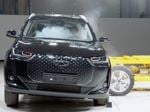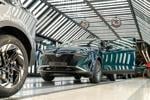It’s a chance for customers to personalise their vehicle and, in some cases, buy into a brand.
But this is a much bigger market for motorcycle dealers and offers the highest margins in the dealership.
Although frame margins are being squeezed, demand for accessories remains healthy, driven by a combination of brand identity, necessity and a customer base wanting to personalise its bikes.
Unlike car owners, bikers require protective clothing to use the vehicle.
This is a significant spend, which normally happens within the dealership either at point of sale or during the first year of ownership.
It offers margins upwards of 30% and many bikers renew their leathers regularly. Matt Marchant, sales executive at Marshall Honda Motorcycles in Peterborough, says: “We make most of our profit from clothing. People normally buy at least one item. With a new bike they’re usually spending £1,000, which makes up for tight deals.”
It’s an opportunity manufacturers have been keen to get involved in.
Like cars, this favours the premium brands; Harley Davidson and Triumph have large and very different ranges of branded protective clothing, and customers are prepared to pay a premium to wear it.
With clothing such a vitally important profit stream, it’s essential to make sure the operation is run effectively.
In order to provide the best service, John Cooke, dealer principal at St Leger Harley Davidson and Subaru, has an in-house clothing shop run by people from the retail industry – a more relevant experience than bike sales.
Bike protection is as important. While most cars are now factory fitted with Thatcham approved alarms and immobilisers, motorcycle manufacturers have yet to take this route.
Fitting alarms is still a major source of profit within a dealership, and finance companies are usually happy to add the cost to monthly payments to ensure the bike is protected.
Simon Read, franchising manager at Honda’s motorcycle division, says: “Honda does a security system called HISS, which is an immobiliser, but bikes don’t tend to come with alarms. There’s scope to make a fair bit of money fitting an alarm.
#AM_ART_SPLIT# “If we had factory fit it would probably mean lost profit for dealers.”
Motorcycle dealerships are also able to generate large profits from personalising customers’ bikes. They usually sell a wide range of bolt-on accessories to do so.
It’s a different market to cars, and bikes can arrive at the dealership without even basic fittings such as screens.
Demand varies between different niches and brands.
Geoff Selvidge, Yamaha UK’s motorcycles division manager, says: “Cruiser riders spend more on bolt-ons for personalisation, usually about £750-£1,000.
Supersport riders buy less, usually along the lines of an exhaust and screen, and are spending £300-£400.”
This makes it vital for dealers to know the products and customers, and be able to advise what they will need for their use of the bike. Demonstrators and showroom stock also needs to display the accessories and matching protective wear.
Though these products generate big profits, carrying a full range will tie up large amounts of cash, particularly for clothing where it’s necessary to have different sizes in stock.
Frank Finch, head of the Motor-cycle Retailers Association, says this can leave dealers vulnerable to competition. “It’s under pressure from eBay and shows, where manufacturers will offload lots of last year’s lines. Dealers need to have the stock, but it’s a tough market. Consumers can try on the clothes in the dealership and buy elsewhere,” he adds.
Clothing and accessory sales are a potentially lucrative market for dealers, with far higher profit margins and more regular customers than selling or servicing vehicles.
But it’s a specialist area and requires know-ledgeable staff to order the right stock and sell effectively to customers.
Case study: Triumph
British bike manufacturer Triumph is a niche brand, linked with a racing heritage and numerous famous fans, and now tied to an extensive merchandise and equipment range.
Triumph products are advertised on its internet site, which attracts 100,000 visitors per month. Around 60% of the existing network carries only the manufacturer’s accessories and protective wear, and new dealers are expected to be solus distributors.
The reward is a 35% margin, with customers buying up to £1,000 of accessories and £450 of protective clothing with a new or used bike.
Other clothing sales are also popular. In March, Triumph launched a T-shirt featuring its most famous rider, Steve McQueen. It sold 6,000 in the first two months.
Mark Heywood, general manager at Triumph, says: “It’s a strong brand to go to market with, it’s iconic. We’ve got 85% brand awareness with motorcyclists, and people want to associate with the brand and display this whether they’re riding or not.”












Login to comment
Comments
No comments have been made yet.